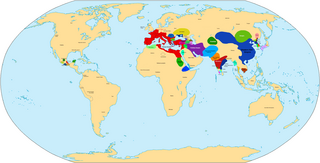Related Research Articles

Boudica or Boudicca was a queen of the ancient British Iceni tribe, who led a failed uprising against the conquering forces of the Roman Empire in AD 60 or 61. She is considered a British national heroine and a symbol of the struggle for justice and independence.

A catapult is a ballistic device used to launch a projectile a great distance without the aid of gunpowder or other propellants – particularly various types of ancient and medieval siege engines. A catapult uses the sudden release of stored potential energy to propel its payload. Most convert tension or torsion energy that was more slowly and manually built up within the device before release, via springs, bows, twisted rope, elastic, or any of numerous other materials and mechanisms.

The ballista, plural ballistae, sometimes called bolt thrower, was an ancient missile weapon that launched either bolts or stones at a distant target.

Valerian was Roman emperor from 253 to spring 260 AD. Valerian is known as the first Roman emperor to have been taken captive in battle, captured by the Persian emperor Shapur I after the Battle of Edessa, causing shock and instability throughout the Roman Empire. The unprecedented event and the unknown fate of the captured emperor generated a variety of different reactions and "new narratives about the Roman Empire in diverse contexts".
A warrior is a guardian specializing in combat or warfare, especially within the context of a tribal or clan-based warrior culture society that recognizes a separate warrior aristocracy, class, or caste.

Adrian Keith Goldsworthy is a British historian and novelist who specialises in ancient Roman history.
Roman siege engines were, for the most part, adapted from Hellenistic siege technology. Relatively small efforts were made to develop the technology; however, the Romans brought an unrelentingly aggressive style to siege warfare that brought them repeated success. Up to the first century BC, the Romans utilized siege weapons only as required and relied for the most part on ladders, towers and rams to assault a fortified town. Ballistae were also employed, but held no permanent place within a legion's roster, until later in the republic, and were used sparingly. Julius Caesar took great interest in the integration of advanced siege engines, organizing their use for optimal battlefield efficiency.

The Principate is the form of imperial government of the Roman Empire from the beginning of the reign of Augustus in 27 BC to the end of the Crisis of the Third Century in AD 284, after which it evolved into the Dominate.
Connor Iggulden is a British author who writes historical fiction, most notably the Emperor series and Conqueror series. He also co-authored The Dangerous Book for Boys with his brother Hal. In 2007, Iggulden became the first person to top the UK fiction and nonfiction lists at the same time.
Balista or Ballista, also known in the sources with the name of "Callistus", was one of the Thirty Tyrants of the controversial Historia Augusta, and supported the rebellion of the Macriani against Emperor Gallienus.

Rome is a historical drama television series released 2005–2007 created by John Milius, William J. MacDonald, and Bruno Heller. The series is set in the 1st century BC, during Ancient Rome's transition from Republic to Empire. The series features a sprawling cast of characters, many based on real figures from historical records, but the lead protagonists are ultimately two soldiers named Lucius Vorenus and Titus Pullo, who find their lives intertwined with key historical events.

Stephen Dando-Collins is an Australian historical author and novelist, with books on antiquity, American, Australian, British, and French history, and the two world wars. He also writes children's novels, the first of which, Chance in a Million,, was filmed by PolyGram as Paws, starring Billy Connolly. In 2012, he started the Caesar the War Dog series of children's novels, based on the true stories of modern-day military dogs serving in Afghanistan and elsewhere, with the fifth in the series published in 2016.
The military history of Europe refers to the history of warfare on the European continent. From the beginning of the modern era to the second half of the 20th century, European militaries possessed a significant technological advantage, allowing its states to pursue policies of expansionism and colonization until the Cold War period. European militaries in between the fifteenth century and the modern period were able to conquer or subjugate almost every other nation in the world. Since the end of the Cold War, the European security environment has been characterized by structural dominance of the United States through its NATO commitments to the defense of Europe, as European states have sought to reap the 'peace dividend' occasioned by the end of the Cold War and reduce defense expenditures. European militaries now mostly undertake power projection missions outside the European continent. Recent military conflicts involving European nations include the 2001 War in Afghanistan, the 2003 War in Iraq, the 2011 NATO Campaign in Libya, and various other engagements in the Balkan and on the African continent. After 2014, the Russian annexation of Crimea and the ongoing Russo-Ukrainian War prompted renewed scholarly interest into European military affairs. For further the context see History of Europe.

Gaius Julius Caesar, one of the most influential men in world history, has frequently appeared in literary and artistic works since ancient times.

Julius Caesar was assassinated by a group of senators on the Ides of March of 44 BC during a meeting of the Senate at the Curia of Pompey of the Theatre of Pompey in Rome where the senators stabbed Caesar 23 times. They claimed to be acting over fears that Caesar's unprecedented concentration of power during his dictatorship was undermining the Roman Republic. At least 60 to 70 senators were party to the conspiracy, led by Marcus Junius Brutus, Gaius Cassius Longinus, and Decimus Junius Brutus Albinus. Despite the death of Caesar, the conspirators were unable to restore the institutions of the Republic. The ramifications of the assassination led to his martyrdom, the Liberators' civil war and ultimately to the Principate period of the Roman Empire.

Celtic mythology is the body of myths belonging to the Celtic peoples. Like other Iron Age Europeans, Celtic peoples followed a polytheistic religion, having many gods and goddesses. The mythologies of continental Celtic peoples, such as the Gauls and Celtiberians, did not survive their conquest by the Roman Empire, the loss of their Celtic languages and their subsequent conversion to Christianity. Only remnants are found in Greco-Roman sources and archaeology. Most surviving Celtic mythology belongs to the Insular Celtic peoples. They preserved some of their myths in oral lore, which were eventually written down by Christian scribes in the Middle Ages. Irish mythology has the largest written body of myths, followed by Welsh mythology.
Fire in the East is a historical novel in the Warrior of Rome Series by Harry Sidebottom, first published in 2008. It is the first novel in the series, focusing on the exploits of Marcus Clodius Ballista, a Roman military officer originally of the Germanic Angles, during the military and political Crisis of the Third Century.
Daisy Florence Dunn is an English author and classicist.

The 0s began on January 1, AD 1 and ended on December 31, AD 9, covering the first nine years of the Common Era. It is one of two "0-to-9" decade-like timespans that contain nine years, along with the 0s BC.
References
- ↑ "WARRIOR OF ROME III: Fordham author hopes for continued success". Newmarket Journal. Retrieved 23 February 2013.
- 1 2 "Tale of derring-do in a crumbling empire". Oxford Times. Retrieved 23 February 2013.
- ↑ "Author Harry's latest book in best-seller list". Newmarket Journal. 18 August 2011. Retrieved 26 February 2013.
- 1 2 3 "It's Classic blood and guts". Oxford Times. Retrieved 23 February 2013.
- ↑ "MJ expands deal with Sidebottom." The Bookseller 10 July 2009: 11. Literature Resource Center. Web. 22 February 2013.
- ↑ "Review: Fire in the East". Publishers Weekly. September 2009. Retrieved 23 February 2013.
- ↑ "Harry Sidebottom: "Wojownik Rzymu. Ogień na Wschodzie"". Wiadomosci 24. 25 January 2010. Retrieved 23 February 2013.
- ↑ "Harry Sidebottom's King of Kings". About.com. Retrieved 23 February 2013.
- ↑ "Civilização com novo livro de Harry Sidebottom". Diario Digital. Retrieved 23 February 2013.
- ↑ "Harry Sidebottom – "Lew Słońca"". HistMag. Retrieved 23 February 2013.
- ↑ "Genre: Historical Thrillers". Telegraph. Retrieved 23 February 2013.
- ↑ "Review: The Caspian Gates". Publishers Weekly. 26 April 2012. Retrieved 23 February 2013.
- ↑ Funari, Pedro (2006). "Harry Sidebottom, Ancient Warfare. Oxford, Oxford University Press, 2004, 170 p". Diálogos. 10 (3): 231–232.
- ↑ "Ancient Warfare: A Very Short Introduction. (Book Review)". Contemporary Review. 286 (1669): 121. February 2005.